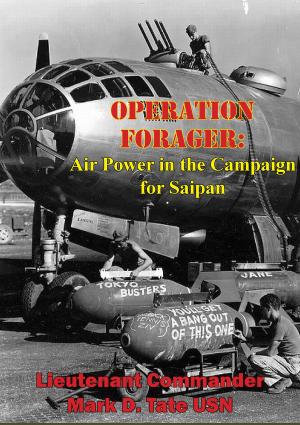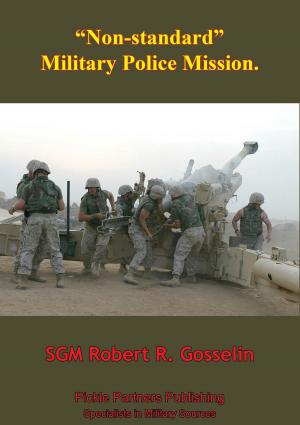The Reich Wreckers: An Analysis Of The 306th Bomb Group During World War II
Nonfiction, History, Germany, European General, Military, United States| Author: | Major Charles J. Westgate III | ISBN: | 9781786256560 |
| Publisher: | Tannenberg Publishing | Publication: | November 6, 2015 |
| Imprint: | Tannenberg Publishing | Language: | English |
| Author: | Major Charles J. Westgate III |
| ISBN: | 9781786256560 |
| Publisher: | Tannenberg Publishing |
| Publication: | November 6, 2015 |
| Imprint: | Tannenberg Publishing |
| Language: | English |
This paper presents an analysis of the 306th Bomb Group’s contributions during World War II. Rather than providing a simple recounting of the various dates and accomplishments, the paper analyzes some of the key indicators and statistics of the group’s performance. In particular, the paper focuses on comparing aircraft losses and bombing results of the 306th with the Eighth Air Force’s. The analysis also examined other areas, such as: mission aborts, enemy aircraft claimed destroyed, weather conditions over target, bombing methods used, presence of fighter escorts, and strength of enemy air defenses (enemy fighter aircraft and flak). The purpose of the analysis was to gain a better understanding of the group’s overall performance within the bigger scope of the Eighth Air Force’s war effort.
The analysis was conducted in three steps. First, the archives of the Air Force Historical Research Agency (AFHRA) were searched for statistics on the 306th. Next, similar statistics were collected for the Eighth Air Force. Finally, the data for the two units was analyzed and compared, to aid in determining conclusions. To facilitate the last step of the research, the air war was divided into four periods. The goals and objectives for each period were used as criteria to grade the unit’s effectiveness.
In general, the study concluded that the 306th Bomb Group was a “typical” B-17 bomber group in World War II. When comparing the various statistics and graphs provide in this paper, we see that in most cases there was little difference in the data for the 306th and the Eighth Air Force. However, the statistics do not tell the whole story. As one of the cadre groups of the Eighth Air Force, many of the improvements and lessons learned during the early period of the war were at the expense of the 306th. These early lessons and experiments were important and led to the improvements that saved many lives and brought an end to the war.
This paper presents an analysis of the 306th Bomb Group’s contributions during World War II. Rather than providing a simple recounting of the various dates and accomplishments, the paper analyzes some of the key indicators and statistics of the group’s performance. In particular, the paper focuses on comparing aircraft losses and bombing results of the 306th with the Eighth Air Force’s. The analysis also examined other areas, such as: mission aborts, enemy aircraft claimed destroyed, weather conditions over target, bombing methods used, presence of fighter escorts, and strength of enemy air defenses (enemy fighter aircraft and flak). The purpose of the analysis was to gain a better understanding of the group’s overall performance within the bigger scope of the Eighth Air Force’s war effort.
The analysis was conducted in three steps. First, the archives of the Air Force Historical Research Agency (AFHRA) were searched for statistics on the 306th. Next, similar statistics were collected for the Eighth Air Force. Finally, the data for the two units was analyzed and compared, to aid in determining conclusions. To facilitate the last step of the research, the air war was divided into four periods. The goals and objectives for each period were used as criteria to grade the unit’s effectiveness.
In general, the study concluded that the 306th Bomb Group was a “typical” B-17 bomber group in World War II. When comparing the various statistics and graphs provide in this paper, we see that in most cases there was little difference in the data for the 306th and the Eighth Air Force. However, the statistics do not tell the whole story. As one of the cadre groups of the Eighth Air Force, many of the improvements and lessons learned during the early period of the war were at the expense of the 306th. These early lessons and experiments were important and led to the improvements that saved many lives and brought an end to the war.

![Cover of the book Like A Thunderbolt: The Lafayette Escadrille And The Advent Of American Pursuit In World War I [Illustrated Edition] by Major Charles J. Westgate III](https://www.kuoky.com/images/2015/november/300x300/9781786252470-JBzr_300x.jpg)






![Cover of the book Helicopters in Irregular Warfare: Algeria, Vietnam, and Afghanistan [Illustrated Edition] by Major Charles J. Westgate III](https://www.kuoky.com/images/2014/august/300x300/9781782895152-A0GJ_300x.jpg)

![Cover of the book Letters On Strategy Vol. II [Illustrated Edition] by Major Charles J. Westgate III](https://www.kuoky.com/images/2015/november/300x300/9781786253699-S3oe_300x.jpg)




![Cover of the book Last Flight From Singapore [Illustrated Edition] by Major Charles J. Westgate III](https://www.kuoky.com/images/2015/november/300x300/9781786257505-nFT2_300x.jpg)